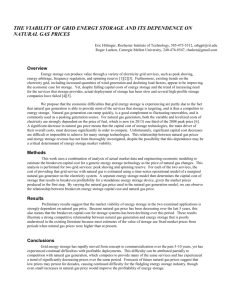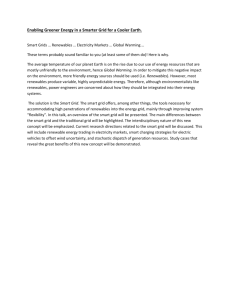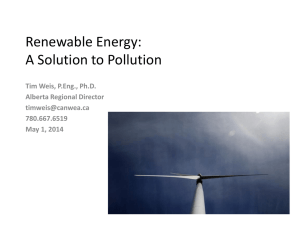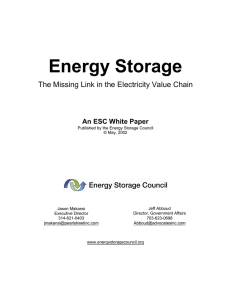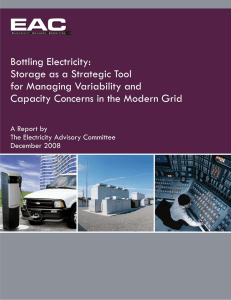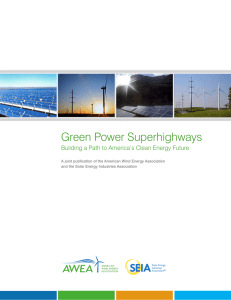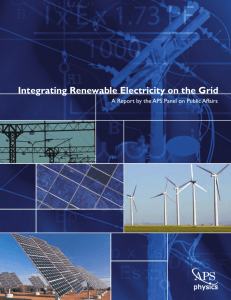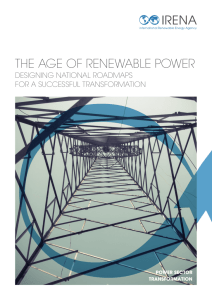how can we store energy for a calm and cloudy day?
advertisement
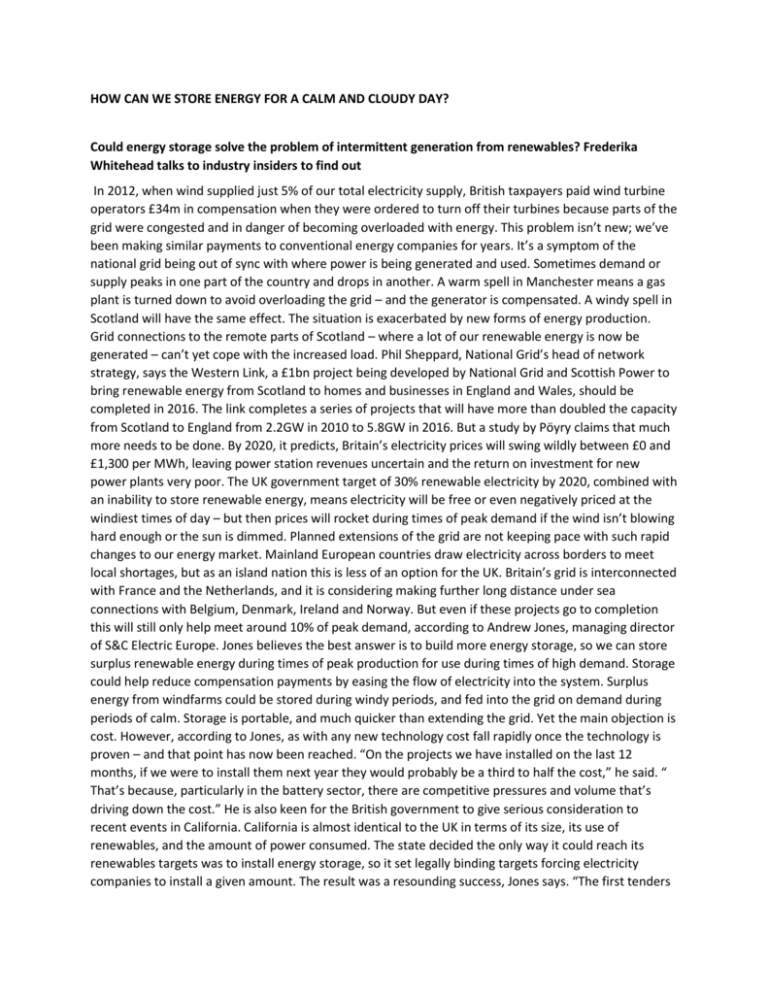
HOW CAN WE STORE ENERGY FOR A CALM AND CLOUDY DAY? Could energy storage solve the problem of intermittent generation from renewables? Frederika Whitehead talks to industry insiders to find out In 2012, when wind supplied just 5% of our total electricity supply, British taxpayers paid wind turbine operators £34m in compensation when they were ordered to turn off their turbines because parts of the grid were congested and in danger of becoming overloaded with energy. This problem isn’t new; we’ve been making similar payments to conventional energy companies for years. It’s a symptom of the national grid being out of sync with where power is being generated and used. Sometimes demand or supply peaks in one part of the country and drops in another. A warm spell in Manchester means a gas plant is turned down to avoid overloading the grid – and the generator is compensated. A windy spell in Scotland will have the same effect. The situation is exacerbated by new forms of energy production. Grid connections to the remote parts of Scotland – where a lot of our renewable energy is now be generated – can’t yet cope with the increased load. Phil Sheppard, National Grid’s head of network strategy, says the Western Link, a £1bn project being developed by National Grid and Scottish Power to bring renewable energy from Scotland to homes and businesses in England and Wales, should be completed in 2016. The link completes a series of projects that will have more than doubled the capacity from Scotland to England from 2.2GW in 2010 to 5.8GW in 2016. But a study by Pöyry claims that much more needs to be done. By 2020, it predicts, Britain’s electricity prices will swing wildly between £0 and £1,300 per MWh, leaving power station revenues uncertain and the return on investment for new power plants very poor. The UK government target of 30% renewable electricity by 2020, combined with an inability to store renewable energy, means electricity will be free or even negatively priced at the windiest times of day – but then prices will rocket during times of peak demand if the wind isn’t blowing hard enough or the sun is dimmed. Planned extensions of the grid are not keeping pace with such rapid changes to our energy market. Mainland European countries draw electricity across borders to meet local shortages, but as an island nation this is less of an option for the UK. Britain’s grid is interconnected with France and the Netherlands, and it is considering making further long distance under sea connections with Belgium, Denmark, Ireland and Norway. But even if these projects go to completion this will still only help meet around 10% of peak demand, according to Andrew Jones, managing director of S&C Electric Europe. Jones believes the best answer is to build more energy storage, so we can store surplus renewable energy during times of peak production for use during times of high demand. Storage could help reduce compensation payments by easing the flow of electricity into the system. Surplus energy from windfarms could be stored during windy periods, and fed into the grid on demand during periods of calm. Storage is portable, and much quicker than extending the grid. Yet the main objection is cost. However, according to Jones, as with any new technology cost fall rapidly once the technology is proven – and that point has now been reached. “On the projects we have installed on the last 12 months, if we were to install them next year they would probably be a third to half the cost,” he said. “ That’s because, particularly in the battery sector, there are competitive pressures and volume that’s driving down the cost.” He is also keen for the British government to give serious consideration to recent events in California. California is almost identical to the UK in terms of its size, its use of renewables, and the amount of power consumed. The state decided the only way it could reach its renewables targets was to install energy storage, so it set legally binding targets forcing electricity companies to install a given amount. The result was a resounding success, Jones says. “The first tenders have been allowed now, they were only intending 50MW of storage. But the targets attracted so much competition there they ended up with close to 150mw of storage for the same budget.” The state succeeded in creating a market. Back in the UK, the Departmetn for Energy and Climate Change says it won’t set a target for storage because it would distort the market. “Our view is that they have already distorted the market with all the other targets and mandates they have in place,” says Jones. Anthony Price, director of the Electricity Storage Network, agrees: “The government says ‘we don’t like picking winners’ but yet it chose wind power, it chose solar, and it has invested in those industries. It has chosen demand side reduction, it has chosen smart meters. It has invested in those areas and it encouraging those industries. It says storage is one of the eight great technologies and we are going to invest millions [of pounds] in university research but we’re not really interested in helping to set up a market.” With current rates of progress, Britain could miss the chance to get a piece of the £280bn global export market, Price warns. He believes the best way forward is to devise and implement a strategy for storage. “The key issue really is that in the UK the government sees renewables as very important part of the future energy strategy, and they’ve produced all manor of strategies for solar, wind and tidal but they haven’t produced a strategy for storage.” “And the downside of that is if they let the industry adopt other mechanisms, such as building more conventional gas power plants to cover peak hours, and then storage will be squeezed out of the market, not just now but for years.” What is energy storage? Types of storage include pumped hydro [pumping water up a hill at times of surplus energy, so that you can later release it to create a flood of hydroelectric power during peak demand]; compressed air; flow batteries; pumped heat; and flywheels. This article is part of the Guardian’s #bigenergydebate series. Click here to find out more about this project and our partners.


